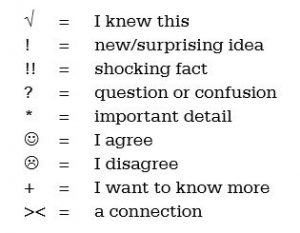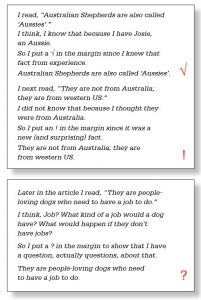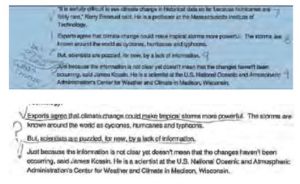Much of the writing we assign our students is public writing—writing to communicate with others. Writing-to-learn is personal writing, writing that helps students increase their comprehension of texts in all disciplines. The 2000 report of the National Reading Panel states, “Teaching students to use…writing to organize their ideas about what they are reading is a proven procedure that enhances comprehension of the text.” Writing to Read: Evidence for How Writing Can Improve Reading, a report commissioned by the Carnegie Corporation (2010), listed that the #1 core instructional practice effective in improving student reading is to “have students write about the texts they read.” Reader response compels readers to interact with the text and makes visible for readers and their teachers the depth of text comprehension. This is the third in a series of columns on scaffolding writing-to-learn by teaching a variety of reader response strategies before, during, and after reading.
During Reading Response: Using Marginal Notes
During-reading response is defined as response students write while they are reading a text. Effective responses should demonstrate that readers are exploring, questioning, and challenging text; visualizing; and making connections, inferences, and predictions to construct meaning from text. However, response should not disrupt or sabotage the reading. Therefore, marginal notes work well for all students, especially reluctant writers, and takes little time away from the reading and discussion of a text. Marginal notes work especially well with informational texts of all types in all disciplines.
The reasons to employ reader response are twofold: for teachers to be able to see what and how students are reading and to guide readers to interact with text and, in that way, increase their comprehension. When readers are trained to mark marginal notes as they read, it fulfills both purposes.
When students read informational text, reading is most interactive and effective when readers consider the facts or statements they are reading:
- I knew this (activating prior knowledge)
- This is a new idea or a surprising fact (noting something new or novel to consider)
- This is shocking (an idea that might go against what would normally be believed or accepted)
- I have a question about this or this is confusing to me (noting where additional information or clarification is wanted or needed)
- This may be important (noting details that seem important or appear that they may become important to understanding the text as a whole)
- I agree with this (noting when something makes sense or fits what is already known)
- I disagree with this (possibly based on something previously learned or read through other venues)
- I want to know more about this (a topic for further research or reading)
- I can make a connection (between the text and experiences the reader has had; between the text and another print, literary, audial, or visual text; or between the text and something going on in the world)
The teacher, or the class together, can assign logos—simple, easy-to-draw, and easy to remember symbols—to each statement, such as

As students read an informational text, they highlight or underline a fact or detail and note a logo in the margin.
Introducing Marginal Notes
It is most effective to introduce readers to the concept of marginal notes by introducing and employing three logos with a text, such as an article, and when the students are familiar with those three, adding two more and then two more, until they are employing all logos as marginal notes to show their thinking. To begin, the easiest logos as marginal notes are

To introduce the concept, the teacher should share an article she has read, highlighting certain statements. The teacher demonstrates what she is thinking when she reads the statement or fact and chooses what logo she is placing in the margin.

The teacher then can progress to a Guided Practice; the students read an article and stop at the same place, underlining the statement, and placing the appropriate logo in the margin. For example, the teacher projected an article from Scholastic magazine. The article began with a statement that the teacher highlighted, “You have probably heard—or even sung—America’s national anthem at a baseball game.” The teacher stated that she would mark the logo that showed her thinking and the students were to highlight that same statement in their copies of the article and each write the logo that showed their thinking.
The teacher explained that she knows that the national anthem is played at baseball games so she placed a √in the margin. Some students who did not play or watch baseball wrote down an ! because, to them, this was a new fact. One student said he knew the anthem was played on televised games but wondered if it was played at all games; he wrote down a ?. Another student wondered if the national anthem was always sung or sometimes just the music was played, and therefore, he wrote down a ? also.
As an independent practice, an article was distributed and students were asked to read the article; highlight 10 facts, details, or statements; and mark the logos that show their thinking in the margins. Teachers may ask students to highlight one fact or statement per paragraph or three from the first third of the text, three from the second third, and three from the last third to be certain that students read the entire article. The number of facts can be altered for different students for differentiation.
A seventh grade science class read an article on climate change:

An eighth grade ELA class reading the novel Of Mice and Men also read an article about “Growing Up on the Steinbeck and Hamilton Ranches in the 1920s and 1930s.” Three of the six students marked the last sentence as * to show a detail they each thought to be important.
![]()
In response to facts in an article about Kristallnacht in a social studies class, the students who marked the most statements as “√ I knew that,” explained that they had read novels on the Holocaust in ELA classes or on their own.
Marginal Notes as Formative Assessment
While the students are reading and making their marginal notes, the teacher can walk around and quickly glance at the margins of papers, getting a feeling about how well the students know the material— if most of the material is already known, if all the material is new, or if they are questioning the material or are confused by it. The logos should be written in the margins (hence, “marginal” notes) so the teacher can walk around and see what types of reactions students are having to the articles and to what areas in the article they are reacting, and also so the students can quickly find them for discussion purposes.
This is a quick formative assessment allowing the teacher to note if he needs to provide more background knowledge before the text is discussed, or, on the other hand, if most students are jotting down many checkmarks, the teacher may inquire why so many students know about the subject and might find that they studied this topic in another grade or read a novel about this topic in the former grade. The teacher can then adjust his teaching. If there are a lot of questions, this text might lead to additional reading.
Using Marginal Notes to Generate Class Discussions
After students have independently read the text and marked notes in the margins, they first go back and cross out any question marks for questions that were answered by the end of the text. They can then be instructed to move into small groups and discuss what they knew, what they each learned, and what questions they still have as a group; groups can analyze if they had more questions or more new information or more “already-knowns.” They use their marginal notes as a basis for their discussion and to build and extend their conversations, discussions that can go in multiple, diverse directions.
It is much easier to generate a discussion when students have their notes in front of them and, looking at the logos, they can remember where they had questions and what facts were new to them. They can explain why they placed a check near a fact. Their notes give them something concrete to discuss. If students have questions in common that the text didn’t answer, they can form inquiry groups based on their questions and collaboratively conduct an inquiry.
After small-group discussion, students can individually choose one underlined fact and copy it in their journals and explain and expand their thinking about that fact.
Teachers have found classes to be more engaged with reading informative texts and deeper, more expansive discussions to be generated with more student participation when using the marked-up texts. Students enjoy comparing what they thought while they were reading with others. In this way, marginal notes lead to increased comprehension of text.